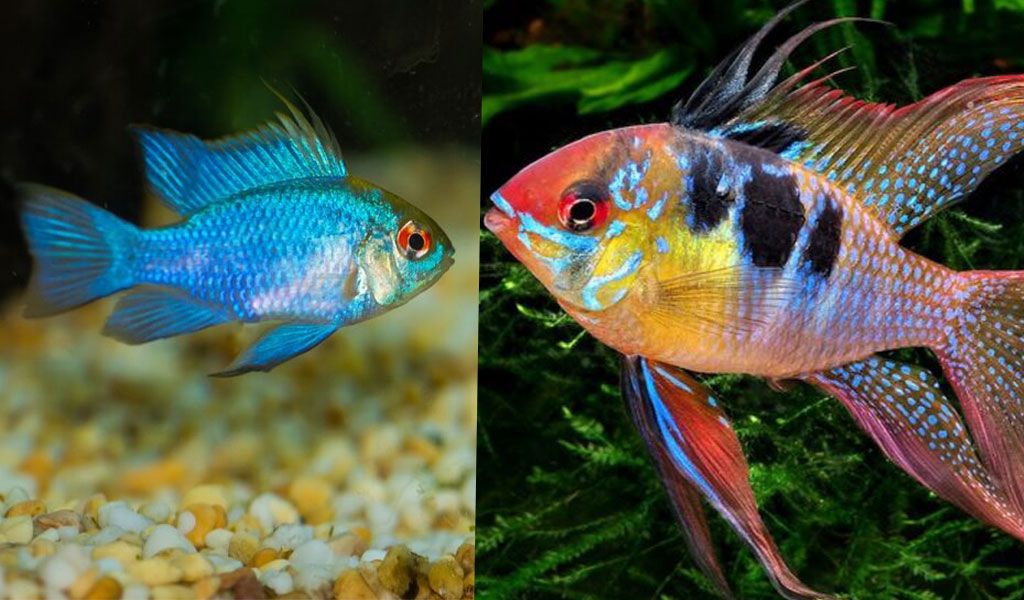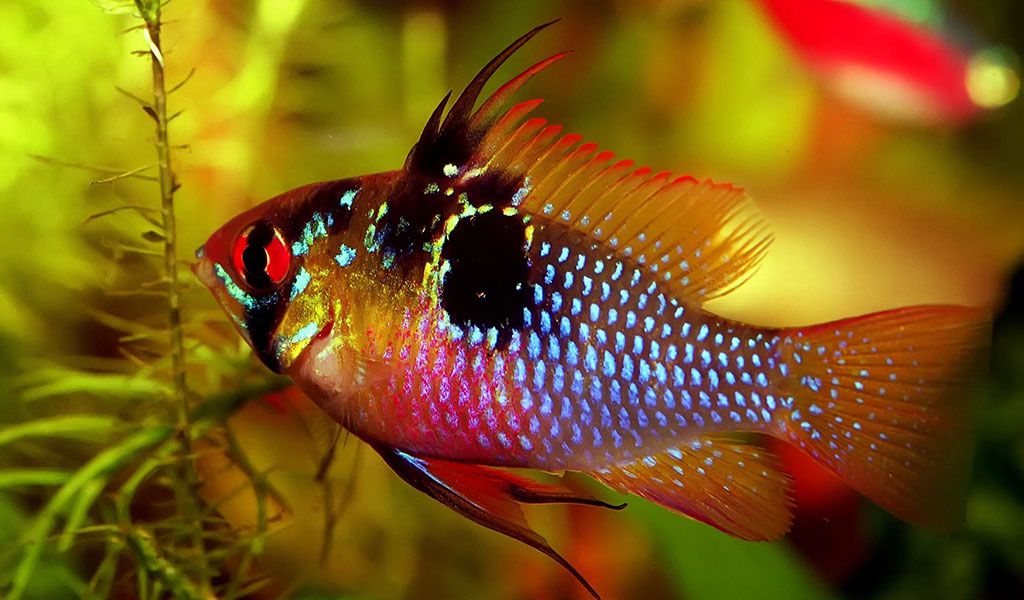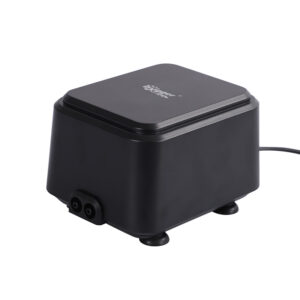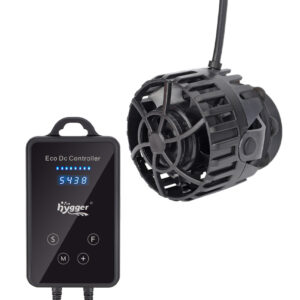German Blue Rams are a freshwater fish, belonging to the Cichlid family. They gain popularity among aquarists because of their stunning appearance and vibrant color. However, the sensitivity to water conditions, the susceptibility to diseases, and the challenges associated with breeding make German Blue Rams keeping in aquariums challenging. Next in this article, we will delve into the German Blue Rams.
Content Table
German blue ram
The German Blue Ram is a popular and visually striking aquarium fish. In this segment, we will cover basic information about the German Blue Ram.
| Scientific name | Mikrogeophagus ramirezi |
| Other names | Electric Blue Ram /Butterfly Cichlid |
| Origin | South America |
| Appearance | 1. A compact and laterally compressed body with a rounded shape. 2. The males typically have more vibrant colors compared to females. 3. Electric blue body, with black markings on the head and dorsal fin, plus slightly red or orange at the tips of fins. |
| Temperament | Peaceful |
| Tank level | Middle-dweller or bottom-dweller |
| Size | 2-2.5 inches |
| Average lifespan | 2–3 years |
| Minimum tank size | 20 gallon |
| Diet | Omnivore |
| Breeding | Egg layer |
| Care Level | Moderate-advanced |
Are German Blue Rams aggressive
German Blue Rams are generally not considered aggressive fish. They have a peaceful nature and can coexist well with other peaceful community fish in a properly set-up aquarium. However, it is important to note that their behavior can vary from individual to individual, and some Rams may exhibit territorial or aggressive tendencies, especially during breeding or when defending their territory.
During the breeding season, German Blue Rams can become territorial, particularly when they have established a pair bond and are preparing to spawn. They may defend a specific area of the tank and become aggressive towards other fish that venture too close to their territory.

To minimize aggression in German Blue Rams, it is necessary to provide ample hiding spots, territories, and visual barriers by adding plants, rocks, or other decorations within the aquarium. It helps to create separate territories and reduces the chances of conflict.
Besides that, it is also essential to avoid keeping German Blue Rams with aggressive or fin-nipping fish species. Aggressive tank mates can stress and harass Rams, leading to increased aggression or damage to their delicate fins.
How difficult to keep the German Blue Rams
Featuring a moderate to advanced care level, keeping German Blue Rams can be challenging, especially for beginners. The Rams are sensitive to water conditions. Next, we will share some care pointers about keeping Rams.
Tank set up
- Tank size
While German Blue Rams are small fish, they require adequate space to swim and establish territories. A minimum tank size of 20 gallons (75 liters) is recommended for a pair of Rams, though larger tanks provide more stability and room for other tank mates.
- Create adequate hiding places
German Blue Rams are generally peaceful but can become territorial during breeding. So it is recommended to provide plenty of hiding places, territories, and visual barriers to reduce aggression. Aquatic plants (e.g. Java fern, Anubias, or Amazon swords), rocks, caves, driftwood, or other decorations will help you out. Also, you can provide a soft and sandy substrate to mimic their natural habitat.
- Necessary aquarium equipment
To maintain great water quality, it is vital to apply a reliable filtration system. An aquarium filter with mechanical, chemical, and biological filtration can remove debris, and toxins, and maintain a healthy and clean environment. Also, Rams prefer calm and slow-moving water, so just provide a gentle water flow.
German Blue Rams thrive in a water temperature of 78-85℉ (25-29℃). Accordingly, to maintain the desired temperature range, you should add an aquarium heater, which helps to keep a stable water temp. While an aquarium thermometer enables you to monitor real-time water temp.
Prepare a water test kit to monitor water parameters. For instance, pH, ammonia, nitrite, and nitrate levels.
Water parameters
| Water temperature | 78-85℉ (25-29℃) | Ammonia level | 0 ppm |
| pH level | 6.0-7.5 | Nitrite level | 0 ppm |
| Water hardness | 5-15 dGH | Nitrate level | Less than 20 ppm |
Feeding
German Blue Rams are omnivorous and should be offered a varied diet. Provide high-quality pellets or flakes specially formulated for cichlids. Plus, supplement their diet with frozen or live foods like bloodworms, brine shrimp, and daphnia to ensure a balanced nutritional intake.

Tank mates
German Blue Rams may be susceptible to aggression or stress from more aggressive or fin-nipping fish. When the comes to tank mates for German Blue Rams, here are some tips:
- Suitable tank mates: peaceful community fish, like tetras, rasboras, small catfish species, peaceful dwarf cichlids, etc.
- Avoid aggressive or fin-nipping fish: German Blue Rams have long, flowing fins that can be targeted for fin nippers such as barbs or aggressive fish like larger cichlids.
How many German Blue Rams should be kept together?
German Blue Rams are typically kept in pairs, with one male and one female. Rams are known to form monogamous pairs and establish a bond with their chosen partner. Keeping a pair allows them to exhibit natural behaviors and potentially breed if the conditions are suitable.
When setting up a tank for German Blue Rams, it is generally recommended to keep a single pair in a tank of at least 20 gallons (75 liters). It provides enough space for the Rams to establish territories and reduces the likelihood of aggression between the pair.
If you have a larger tank, you can consider keeping multiple pairs of German Blue Rams, but it is important to provide ample space and hiding spots to minimize aggression. A tank size of 40 gallons (150 liters) or larger is generally recommended for multiple pairs or a small community of Rams.
It is worth noting that while some aquarists have successfully kept multiple pairs of German Blue Rams together, it can be more challenging to maintain peace and harmony in the tank. Aggression and territorial disputes may arise, especially during breeding or when establishing territories. Monitor their behavior closely and separate any aggressive individuals in the face of conflicts.
To sum up
German Blue Rams are small and peaceful fish, while they can be aggressive sometimes. Definitely, the Rams are not ideal for beginners because of their sensitivity to water conditions, plus aggressive and territorial behavior during breeding season.


Leave a comment